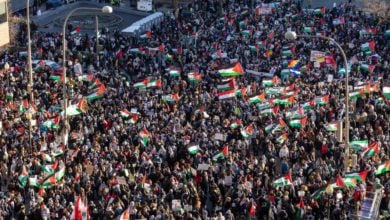 The latest Israeli war on the Palestinian people in Gaza is now entering its 13th day. More correctly, the latest Israeli offensive in a nearly seven decades-long war against the Palestinians is now in its 13th day.
The latest Israeli war on the Palestinian people in Gaza is now entering its 13th day. More correctly, the latest Israeli offensive in a nearly seven decades-long war against the Palestinians is now in its 13th day.
Why is this assault happening now? A brief look at the historical background can help provide context.
The current offensive has a more specific purpose, namely smashing the new unity agreement reached in April between Hamas, Fatah and the other parties represented in the Palestine Liberation Organization.
The Zionist project, which led to the creation of the state of Israel, was born in the late 19th century. Its central idea was the creation of an independent Jewish state. Political Zionism was a response to widespread anti-Jewish racism in Europe. But at the same time, it was a colonial project from the start, with a similar attitude toward the indigenous Arab people of Palestine as European settlers had toward the indigenous people from South Africa to China to right here in what became the United States of America.
Zionism was a nationalist movement. Once its leaders fixed on Palestine, they were dedicated to displacing the Palestinian people in order to make way for the creation of their state. Zionism was a minority movement among Jewish people in Europe until the Nazi mass murder during World War II.
When World War II ended in 1945, the Zionist settler movement was much better funded and armed than were the Palestinians, whose mass rebellion had been crushed in 1939 by the British after a three-year-long struggle. While the Zionists had organized armed units and large-scale financial support from outside, Palestinians were in a weakened position. Palestinians were subject to execution for even possessing a gun.
On November 29, 1947, the United Nations illegally voted by a narrow margin to partition, the British colony of Palestine into two states. While Zionist settlers owned only 6 percent of the land and comprised 35 percent of the population, 56 percent of Palestine was designated for the state of Israel.
In the war that followed, Israel conquered 78 percent of the land and drove out 750,000 – 800,000 Palestinians by means of massacre and other forms of terror, as has been irrefutably documented by many Israeli as well as Palestinian historians. Thousands of Palestinians homes, farms, orchards and shops were confiscated by the Israelis. What the Zionists did not want to keep, they destroyed, including 536 Palestinian villages that were wiped off the map.
Even so, the next year Moshe Dayan, then a rising military officer and later prime minister, told a U.S. diplomat at a cocktail party in Tel Aviv: “Boundaries, frontier of Israel should be on the Jordan River . . . Present boundaries ridiculous from all points of view.” In other words, from the very foundation of the Israeli state, its leaders had their eyes on expanding to take over the West Bank. And, as events would soon show, the Israeli leaders also had their ambitions set on conquering parts of Syria, Egypt and Lebanon as well.
In the 1950s, the government of David Ben-Gurion, Israel’s first prime minister, pursued this objective through a “Second Round,” a second war with the Arab countries, and particularly with Jordan, which had taken over the West Bank in 1948.
But in order to maintain the support of world and especially U.S. public opinion, the Israeli leaders sought to justify a new war by making Israel appear to be victim rather than aggressor.
The Black Panther Party’s saying about racist cops who justified their routine brutalizing and killing of oppressed people by “masquerading as the victim of an unprovoked attack,” perfectly describes an Israeli tactic that continues down to the present day. In the U.S. and Israeli mass media, Israel is almost always “retaliating,” implying that it is acting in self-defense. In fact, the opposite has, with very rare exceptions, been the case.
In 1953, an Israeli special forces unit under the command of another future prime minister, Ariel Sharon, “retaliated” for a small-scale Palestinian raid by wiping out most of the village of Qibya in the West Bank, killing 60 people, many of them trapped in a building and burned alive. The aim was to get the Jordanian army to respond, starting the “Second Round,” which Ben-Gurion hoped would lead to the conquest of the West Bank. It didn’t and there was worldwide condemnation of Israel’s action.
In 1956, again using the justification of “retaliation,” Israeli invaded and occupied the Sinai Peninsula in coordination with Britain and France, who also attacked Egypt. This too failed and Israel was forced to withdraw.
But 14 years later in 1967—again claiming to be threatened—Israel launched the Six-Day War that ended with the Golan Heights, West Bank, Gaza and the Sinai Peninsula under Israel control. Thirty years after the fact, Moshe Dayan admitted to the NY Times that this claim was completely false.
In 1982, Israel invaded and occupied Lebanon, again, with the claim of retaliation for the attempted assassination of an Israeli diplomat in London. Had it not been for the fierce and persistent Lebanese resistance, it is likely that Israel would remain in control of southern Lebanon today.
Can anyone see a pattern here?
After the 1967 war, Israel illegally annexed Syria’s Golan Heights and East Jerusalem and began settlements in the West Bank and Gaza. Today, there are more than 500,000 Israeli settlers in the West Bank. While Israel withdrew its troops and settlers from inside Gaza in 2005, Gaza has remained blockaded, isolated and dominated by the Israeli army, navy and air force. Egypt has also severely restricted its crossing with Gaza.
After the Hamas party won the 2006 Palestinian legislature election, the U.S., European Union and Israel tightened the blockade as their “democratic” response to an election outcome they didn’t like.
Shortly afterward, Israeli’s Ha’aretz newspaper reported that at a meeting of leading government officials, Dov Weisglass, a top advisor to then Israeli prime minister Ehud Olmert, told a “joke”: “It’s like an appointment with a dietician. The Palestinians will get a lot thinner but won’t die.” The assembled officials, Ha’aretz reported, “rolled with laughter,” at the new suffering to be imposed on 1.8 million Gaza residents—most of them refugees from other parts of Palestine.
On the day after the 2008 U.S. election, Israel murdered five Palestinian civilians, breaking a ceasefire and setting in motion a chain of events that led to an all-out military assault on Gaza. In response to the murders, Palestinian resistance units fired rockets into southern Israel. When Israel launched a massive assault, it was dutifully reported by the U.S. corporate media that it was once again “retaliating.”
In “Operation Cast Lead,” the Israeli military deployed a vast array of weaponry, including white phosphorous and depleted uranium munitions, on a trapped population. More than 1,400 Palestinians were killed, while Israeli forces had 13 killed—a ratio of more than 100 to 1.
Four years later, the fatal shooting of a mentally disabled young man on Nov. 5 and a 12-year-old boy on Nov. 9, both killed by the Israeli army inside Gaza, set off the new round of fighting. Then, on Nov. 14, Israel assassinated a top Hamas leader, Ahmed Al-Jaabari, the very day that he had been presented with a proposal for a long-term ceasefire by a joint Israeli-Egyptian group. When rockets were fired from Gaza, Israel launched “Operation Pillar of Defense,” a week-long bombing campaign in which 162 Palestinians were killed and more than 1,400 wounded. Six Israelis were killed.
In the current “Operation Protective Edge,” more than 250 Palestinians have been killed and 1,700 wounded, while Israel has had two killed.
The recurrent brutal and cowardly assaults on a largely defenseless population—the Palestinians have no army, navy, air force or air defenses—are frequently described by Israeli leaders with the racist and dehumanizing phrase “mowing the grass.”
But the current offensive also has a more specific purpose, namely smashing the new unity agreement reached in April between Hamas, Fatah and the other parties represented in the Palestine Liberation Organization.
While the Palestinian masses celebrated the agreement, both the Israeli and U.S. governments expressed shocked and angry opposition. Israeli Prime Minister Binyamin Netanyahu launched a campaign demanding that Palestinian Authority President Mahmoud Abbas break the agreement. There would be no “peace negotiations,” Netanyahu proclaimed, as long as the unity agreement remained in effect.
Killing of settler youth a pretext
When three Israeli settler youth disappeared on June 12, Netanyahu immediately accused Hamas of the kidnapping, though he produced no supporting evidence, and intensified his campaign against the Palestinian unity pact. On the pretext of “searching” for the settler youth, who the Israeli military believed from the day of their disappearance were dead, a massive roundup of Hamas leaders and activists was carried out in the West Bank with more than 400 imprisoned including 12 members of the Palestinian parliament.
After the burning alive of a 16-year-old Palestinian youth on June 30 by Israeli fascists in Jerusalem, massive Palestinian demonstrations and street fighting took place across the West Bank.
On July 8, Israel launched “Operation Protective Edge,” and has since carried out thousands of bombing and shelling attacks on Gaza. The military wing of Hamas and other resistance organizations have fired thousands of rockets, which are not nearly as accurate or powerful as Israeli weaponry. Yesterday, Israel launched a ground invasion of Gaza.
As of today, July 18, the Palestinian death toll has risen to nearly 300, the vast majority civilians and many children. The Israeli death toll is reported as two, one soldier and one man working with the army. The U.S. government has fully supported Israel’s deadly assault and continued to present the Israelis as the “victims.”
In another step in the campaign to break the nascent Palestinian unity, Palestinian Authority President Abbas was included in negotiations held in Cairo for a ceasefire agreement, while Hamas representatives were excluded.
Hamas rejected the agreement on the basis that it included no end to the blockade and isolation of Gaza.
Based on a presentation by Richard Becker at an ANSWER Coalition Forum in Los Angeles, July 18, 2014. Read Becker’s book, Palestine, Israel and the U.S. Empire.






